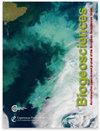The fingerprint of climate variability on the surface ocean cycling of iron and its isotopes
IF 3.9
2区 地球科学
Q1 ECOLOGY
引用次数: 0
Abstract
Abstract. The essential micronutrient iron (Fe) limits phytoplankton growth when dissolved Fe (dFe) concentrations are too low to meet biological demands. However, many of the processes that remove, supply, or transform Fe are poorly constrained, which limits our ability to predict how ocean productivity responds to ongoing and future changes in climate. In recent years, isotopic signatures (δ56Fe) of Fe have increasingly been used to gain insight into the ocean Fe cycle, as distinct δ56Fe endmembers of external Fe sources and δ56Fe fractionation during processes such as Fe uptake by phytoplankton can leave a characteristic imprint on dFe signatures (δ56Fediss). However, given the relative novelty of these measurements, the temporal scale of δ56Fediss observations is limited. Thus, it is unclear how the changes in ocean physics and biogeochemistry associated with ongoing or future climate change will affect δ56Fediss on interannual to decadal timescales. To explore the response of δ56Fediss to such climate variability, we conducted a suite of experiments with a global ocean model with active δ56Fe cycling under two climate scenarios. The first scenario is based on an atmospheric reanalysis and includes recent climate variability (1958–2021), whereas the second comes from a historical and high-emissions climate change simulation to 2100. We find that under recent climatic conditions (1975–2021), interannual δ56Fediss variability is highest in the tropical Pacific due to circulation and productivity changes related to the El Niño–Southern Oscillation (ENSO), which alter both endmember and uptake fractionation effects on δ56Fediss by redistributing dFe from different external sources and shifting nutrient limitation patterns. While the tropical Pacific will remain a hotspot of δ56Fediss variability in the future, the most substantial end-of-century δ56Fediss changes will occur in the Southern Hemisphere at middle to high latitudes. These arise from uptake fractionation effects due to shifts in nutrient limitation. Based on these strong responses to climate variability, ongoing measurements of δ56Fediss may help diagnose changes in external Fe supply and ocean nutrient limitation.气候变率对表层海洋铁循环及其同位素的影响
摘要当溶解的铁(dFe)浓度过低而不能满足生物需求时,必需微量元素铁(Fe)会限制浮游植物的生长。然而,许多去除、供应或转化铁的过程都没有得到很好的约束,这限制了我们预测海洋生产力如何应对正在发生的和未来的气候变化的能力。近年来,铁的同位素特征(δ56Fe)越来越多地用于了解海洋铁循环,因为外部铁源的不同δ56Fe端元和浮游植物吸收铁过程中的δ56Fe分馏可以在dFe特征(δ56Fediss)上留下特征印记。然而,由于这些测量相对新颖,δ56Fediss观测的时间尺度是有限的。因此,目前尚不清楚与当前或未来气候变化相关的海洋物理和生物地球化学变化将如何影响年际至年代际时间尺度上的δ 56fedis。为了探讨δ56Fe对这种气候变率的响应,我们在两种气候情景下,利用δ56Fe活跃循环的全球海洋模式进行了一系列实验。第一种情景基于大气再分析,包括最近的气候变率(1958-2021),而第二种情景基于到2100年的历史和高排放气候变化模拟。在最近的气候条件下(1975-2021),热带太平洋的δ56Fediss年际变化最大,这是由于与El Niño-Southern涛动(ENSO)相关的环流和生产力变化,这些变化通过重新分配来自不同外部来源的dFe和改变营养限制模式,改变了端元和吸收分异对δ56Fediss的影响。虽然热带太平洋在未来仍将是δ56Fediss变率的热点,但本世纪末δ56Fediss最显著的变化将发生在南半球的中高纬度地区。这是由于营养限制变化引起的吸收分馏效应引起的。基于这些对气候变率的强烈响应,δ56Fediss的持续测量可能有助于诊断外部铁供应和海洋营养限制的变化。
本文章由计算机程序翻译,如有差异,请以英文原文为准。
求助全文
约1分钟内获得全文
求助全文
来源期刊

Biogeosciences
环境科学-地球科学综合
CiteScore
8.60
自引率
8.20%
发文量
258
审稿时长
4.2 months
期刊介绍:
Biogeosciences (BG) is an international scientific journal dedicated to the publication and discussion of research articles, short communications and review papers on all aspects of the interactions between the biological, chemical and physical processes in terrestrial or extraterrestrial life with the geosphere, hydrosphere and atmosphere. The objective of the journal is to cut across the boundaries of established sciences and achieve an interdisciplinary view of these interactions. Experimental, conceptual and modelling approaches are welcome.
 求助内容:
求助内容: 应助结果提醒方式:
应助结果提醒方式:


